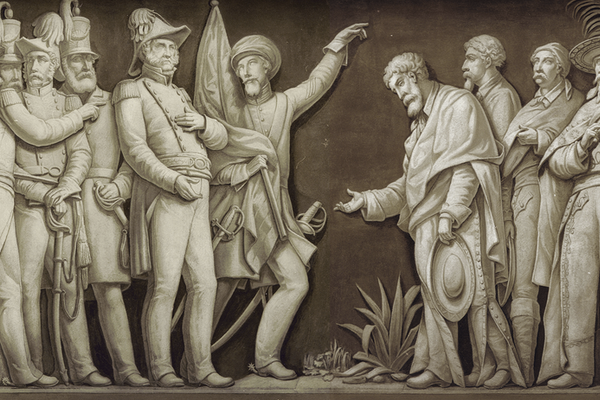The Mexican War Suggests Ukraine May End Up Conceding Crimea. World War I Suggests the Price May Be Tragic if it Doesn't

"American Army Entering the City of Mexico" by Filippo Constaggini, 1885. Architect of the Capitol.
In April 1846, the United States invaded Mexico after a highly disputed incident at the border. Freshman Congressman Abraham Lincoln challenged President James Polk’s account of Mexican provocations as misleading and demanded to know the “spot” where they supposedly took place.
None of the major European powers got involved on either side. Great Britain remained officially neutral during the war, although it objected to an American blockade that interfered with its trade with Mexico. France was uninvolved but insisted that Mexico remain an independent nation.
By September 1847, American forces had captured the Mexican capital and forced surrender. An overwhelmed Mexico signed the 1848 Treaty of Guadalupe Hidalgo, ending the war and transferring to the United States over half of its territory, including modern day California, Nevada, Utah, and most of present day Colorado, New Mexico, and Arizona. Mexico was also forced to drop its claims to the former Mexican province of Texas and accept the Rio Grande as the new border between the countries. In return, the United States paid Mexico a consideration of fifteen million U.S. dollars, worth between 500 and 600 million dollars in today’s money.
Mexico is never going to receive its stolen territory back. The annual economy of California today alone is $3.5 trillion, approximately three times that of Mexico.
Fast forward to 1913, when Europe was divided into two military alliances. The Central Powers (Germany, the Austro-Hungarian Empire, and Italy, later joined by the Ottoman Empire and Bulgaria), faced off against the Triple Entente (Great Britain, France and the Russian Empire, later to be joined by the United States and Italy when it changed sides). The alliances provided some stability in Europe, much like NATO and the Warsaw Pact alliances did during the Cold War, but also set conditions for the situation in Europe to rapidly spiral out of control.
On July 28, 1914, Austria-Hungary invaded Serbia after the assassination of the Austrian Archduke in Sarajevo, which had been annexed by Austria-Hungary in 1908. The assassins hoped to liberate Bosnia and Herzegovina from Austro-Hungarian rule. On August 8 Montenegro joined in the defense of Serbia, and on August 9 Russia, an ally of Serbia, attacked German and Austro-Hungarian positions. Meanwhile, Germany invaded Belgium, bringing France and Great Britain into the war. In the east, Russia collapsed, but in the west the two alliances stalemated. The war dragged on until the German collapse in the fall of 1918. Military and civilian casualties during World War I, deaths and injuries, were an estimated 40 million people. The punitive treaty that ended the war became an underlying cause of World War 2 and the deaths of another 80 million people.
Fast forward again, this time to more recent decades. With the collapse of the Soviet Union, Ukraine and Russia became independent countries, with the former Soviet Black Sea naval base now located in Ukraine after Crimea was administratively transferred from Russia to Ukraine in the 1950s. In 2014, a Ukrainian government allied with Russia was replaced by a westward leaning government, and Russia seized Crimea and its warm water naval base in violation of international agreements established after World War II protecting the territorial integrity of nations. In response, western nations placed economic sanctions on Russia, and NATO expanded eastward and considered admitting Ukraine into the alliance. Russia responded by invading Ukraine with the goals of putting a friendly government into power there and annexing territories on the Russian-Ukrainian border. The invasion stalled when NATO, including the United States, armed the Ukrainian military with modern weaponry more sophisticated than that used by Russian forces. It is now a war between NATO and Russia, although still a limited war, not just a war between Ukraine and Russia.
Ukrainian President Volodymyr Zelensky continually pressures NATO and the United States to provide Ukraine with more advanced weaponry. NATO has already agreed to deliver tanks, anti-missile systems, drones, and rockets, but Zelensky wants fighter jets that will allow Ukraine to shift from a defensive war and attack targets deep inside Russia.
The United States and NATO face a serious dilemma. They are committed to supporting Ukraine and preserving its national integrity, but Zelensky is demanding that Russia return all occupied territory, including Crimea, and pay reparations to rebuild areas of Ukraine that were destroyed by the Russian invasion, demands that Russia will never accept. Russia will not return Crimea to Ukraine, just as the United States will never return California to Mexico.
If NATO and the United States deliver jet fighters and Ukraine uses them to attack Russian targets, including cities, the world faces an escalating domino effect similar to that which started World War 1 and led to World War 2. That is why as a historian, I am really worried about events playing out in Ukraine. The only peaceful resolution that I see is Ukraine agreeing to accept Russia control over Crimea and some of the disputed border areas in exchange for the NATO alliance rebuilding areas destroyed by the war. NATO and Russia will then have to find a resolution to their differences, but I am not hopeful they will find an amicable solution.